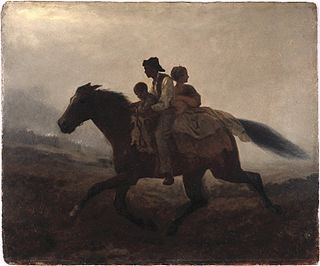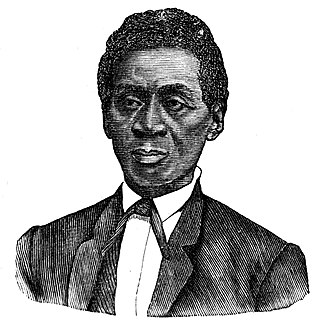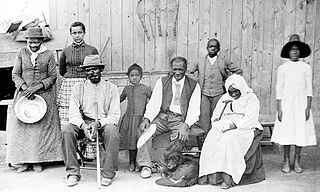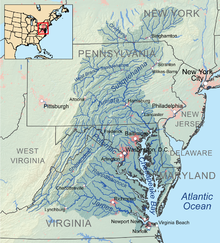
The Underground Railroad was a network of clandestine routes and safe houses established in the United States during the early- to the mid-19th century. It was used by enslaved African Americans primarily to escape into free states and Canada. The network was assisted by abolitionists and others sympathetic to the cause of the escapees. The enslaved persons who risked escape and those who aided them are also collectively referred to as the "Underground Railroad". Various other routes led to Mexico, where slavery had been abolished, and to islands in the Caribbean that were not part of the slave trade. An earlier escape route running south toward Florida, then a Spanish possession, existed from the late 17th century until approximately 1790. However, the network now generally known as the Underground Railroad began in the late 18th century. It ran north and grew steadily until the Emancipation Proclamation was signed by President Abraham Lincoln. One estimate suggests that by 1850, approximately 100,000 enslaved people had escaped to freedom via the network.

Harriet Tubman was an American abolitionist and social activist. Born into chattel slavery, Tubman escaped and subsequently made some 13 missions to rescue approximately 70 similarly-enslaved people, including her family and friends, using the network of antislavery activists and safe houses known as the Underground Railroad. During the American Civil War, she served as an armed scout and spy for the Union Army. In her later years, Tubman was an activist in the movement for women's suffrage.

William Still was an African-American abolitionist based in Philadelphia, Pennsylvania. He was a conductor on the Underground Railroad and was responsible for helping 650 freedom seekers make their way to Canada. Still was also a businessman, writer, historian and civil rights activist. Before the American Civil War, Still was chairman of the Vigilance Committee of the Pennsylvania Anti-Slavery Society, named the Vigilant Association of Philadelphia. He directly aided fugitive slaves and also kept records of the people served in order to help families reunite.

The Pearl incident was the largest recorded nonviolent escape attempt by enslaved people in United States history. On April 15, 1848, seventy-seven slaves attempted to escape Washington D.C. by sailing away on a schooner called The Pearl. Their plan was to sail south on the Potomac River, then north up the Chesapeake Bay and Delaware River to the free state of New Jersey, a distance of nearly 225 miles (362 km). The attempt was organized by both abolitionist whites and free blacks, who expanded the plan to include many more enslaved people. Paul Jennings, a former slave who had served President James Madison, helped plan the escape.

In the United States, fugitive slaves or runaway slaves were terms used in the 18th and 19th centuries to describe people who fled slavery. The term also refers to the federal Fugitive Slave Acts of 1793 and 1850. Such people are also called freedom seekers to avoid implying that the enslaved person had committed a crime and that the slaveholder was the injured party.

Samuel Green was a slave, freedman, and minister of religion. A conductor of the Underground Railroad, he was tried and convicted in 1857 of possessing a copy of the anti-slavery novel Uncle Tom's Cabin by Harriet Beecher Stowe following the Dover Eight incident. He received a ten-year sentence, and was pardoned by the Governor of Maryland Augustus Bradford in 1862, after he served five years.

Thomas Garrett was an American abolitionist and leader in the Underground Railroad movement before the American Civil War. He helped more than 2,500 African Americans escape slavery.

The Cyrus Gates Farmstead is located in Maine, New York. Cyrus Gates was a cartographer and map maker for New York State, as well as an abolitionist. The great granddaughter of Cyrus-Louise Gates-Gunsalus has stated that from 1848 until the end of slavery in the United States in 1865, the Cyrus Gates Farmstead was a station or stop on the Underground Railroad. Its owners, Cyrus and Arabella Gates, were outspoken abolitionists as well as active and vital members of their community. Historian Shirley L. Woodward states that through those years escaped slaves came through the Gates' station.

Samuel D. Burris was a member of the Underground Railroad. He had a family, who he moved to Philadelphia for safety and traveled into Maryland and Delaware to guide freedom seekers north along the Underground Railroad to Pennsylvania.

Songs of the Underground Railroad were spiritual and work songs used during the early-to-mid 19th century in the United States to encourage and convey coded information to escaping slaves as they moved along the various Underground Railroad routes. As it was illegal in most slave states to teach slaves to read or write, songs were used to communicate messages and directions about when, where, and how to escape, and warned of dangers and obstacles along the route.

Mary Edmonson (1832–1853) and Emily Edmonson, "two respectable young women of light complexion", were African Americans who became celebrities in the United States abolitionist movement after gaining their freedom from slavery. On April 15, 1848, they were among the 77 slaves who tried to escape from Washington, DC on the schooner The Pearl to sail up the Chesapeake Bay to freedom in New Jersey.

The Reverse Underground Railroad is the name given, sardonically, to the pre-American Civil War practice of kidnapping in free states not only fugitive slaves but free blacks as well, transporting them to slave states, and selling them as slaves, or occasionally getting a reward for return of a fugitive. Those who used the term were pro-slavery and angered at an "underground railroad" helping slaves escape. Also, the so-called "reverse underground railroad" had incidents but not a network, and its activities did not always take place in secret. Rescues of blacks being kidnapped were unusual.

The Harriet Tubman Underground Railroad Visitor Center is a visitors' center and history museum located on the grounds of the Harriet Tubman Underground Railroad State Park in Church Creek, Maryland, in the United States. The state park is surrounded by the Blackwater National Wildlife Refuge, whose north side is bordered by the Harriet Tubman Underground Railroad National Historical Park. Jointly created and managed by the National Park Service and Maryland Park Service, the visitor center opened on March 10, 2017.

Harriet Tubman's birthplace is in Dorchester County, Maryland. Araminta Ross, the daughter of Benjamin (Ben) and Harriet (Rit) Greene Ross, was born into slavery in 1822 in her father's cabin. It was located on the farm of Anthony Thompson at Peter's Neck, at the end of Harrisville Road, which is now part of the Blackwater National Wildlife Refuge.

Harriet Tubman (1822 – 1913) was an American abolitionist and political activist. Tubman escaped slavery and rescued approximately 70 enslaved people, including members of her family and friends. Harriet Tubman's family includes her birth family; her two husbands, John Tubman and Nelson Davis; and her adopted daughter Gertie Davis.
The Dover Eight refers to a group of eight black people who escaped their slaveholders of the Bucktown, Maryland area around March 8, 1857. They were helped along the way by a number of people from the Underground Railroad, except for Thomas Otwell, who turned them in once they had made it north to Dover, Delaware. There, they were lured to the Dover jail with the intention of getting the $3,000 reward for the eight men. The Dover Eight escaped the jail and made it to Canada.
William Brinkley was a conductor on the Underground Railroad who helped more than 100 people achieve freedom by traveling from Camden, Delaware past the "notoriously dangerous" towns of Dover and Smyrna north to Blackbird and sometimes as far as Wilmington, which was also very dangerous for runaway enslaved people. Some of his key rescues include the Tilly Escape of 1856, the Dover Eight in the spring of 1857, and the rescue of 28 people, more than half of which were children, from Dorchester County, Maryland. He had a number of pathways that he would take to various destinations, aided by his brother Nathaniel and Abraham Gibbs, other conductors on the railroad.

A group of 28 enslaved people from Maryland escaped their slaveholders on October 24, 1857. They were a group of two dozen enslaved men, women, and children who fled from Dorchester County, Maryland. Four men joined their group to travel north along the Underground Railroad.

















